Research line
Mobile Robotics and Intelligent Systems

The research activities of the MOBILE ROBOTICS line are aimed to endow mobile robots and ubiquitous computing devices the necessary skills to aid humans in everyday life activities. These skills range from pure perceptual activities such as tracking, recognition or situation awareness, to motion skills, such as localization, mapping, autonomous navigation, path planning or exploration. ❯ See our presentation video ❯
Head of line: Alberto Sanfeliu Cortés

Research areas
>> Urban service robotics
>> Social robotics
>> Robot localization and robot navigation
>> SLAM and robot exploration
>> Tracking in computer vision
>> Object recognition

Tech. transfer
Our activity finds applications in several fields through collaboration with our technological partners
Research projects
We carry out projects from national and international research programmes.
→ More about our research projects
<< Back to Mobile Robotics and Intelligent Systems main page
Urban service robotics
The group focuses on the design and development of service mobile robots for human assistance and human robot interaction. This includes research on novel hardware and software solutions to urban robotic services such as surveillance, exploration, cleaning, transportation, human tracking, human assistance and human guiding.
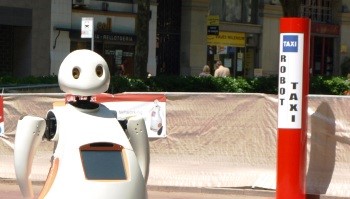
Social robotics
The group's work on social robotics has an emphasis in human robot interaction and collaboration, developing new techniques to predict and learn human behaviors, human-robot task collaboration, and the generation of emphatic robot behaviors using all types of sensors, computer vision techniques and cognitive systems technologies.
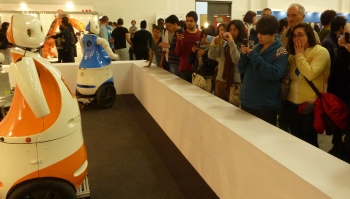
Robot localization and robot navigation
This research area tackles the creation of robust single and cooperative, indoor and outdoor robot localization solutions, using multiple sensor modalities such as GPS, computer vision and laser range finding, INS sensors and raw odometry. The area also seeks methods and algorithms for autonomous robot navigation, and robot formation; and the application of these methods on a variety of indoor and outdoor mobile robot platforms.
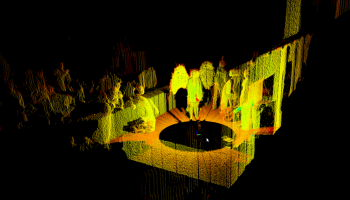
SLAM and robot exploration
We develop solutions for indoor and outdoor simultaneous localization and mapping using computer vision and three-dimensional range data using Bayesian estimation. The research includes the development of new filtering and smoothing algorithms that limit the load of maps using information theoretic measures; as well as the design and construction of novel sensors for outdoor mapping. This research area also studies methods for autonomous robotic exploration.
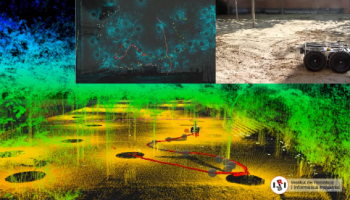
Tracking in computer vision
We study the development of robust algorithms for the detection and tracking of human activities in indoor and outdoor areas, with applications to service robotics, surveillance, and human-robot interaction. This includes the development of fixed/moving single camera tracking algorithms as well as detection and tracking methods over large camera sensor networks.
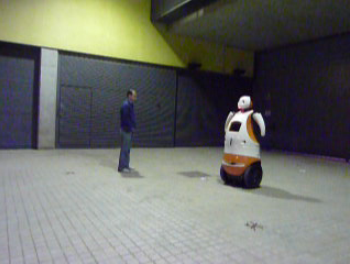
Object recognition
The group also performs research on object detection and object recognition in computer vision. Current research is heavily based on boosting and other machine learning methodologies that make extensive use of multiple view geometry. We also study the development of unique feature and scene descriptors, invariant to changes in illumination, cast shadows, or deformations.
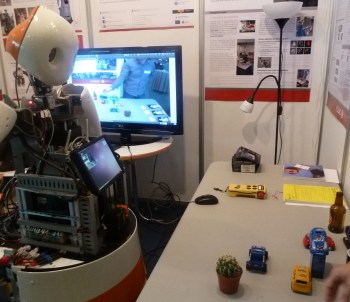
These are the latest research projects of the Mobile Robotics and Intelligent Systems research line:
-

TRIFFID: auTonomous Robotic aId For increasing FIrst responDers efficiency
European Project
Start Date: 01/10/2024
-

CANOPIES: A Collaborative Paradigm for Human Workers and Multi-Robot Teams in Precision Agriculture Systems
European Project
Start Date: 01/01/2021
-

LOGISMILE 2023: Last mile logistics for autonomous goods delivery
European Project
Start Date: 01/05/2023
-

LOGISMILE: Last mile logistics for autonomous goods delivery
European Project
Start Date: 01/01/2022
-

TERRINET: The European robotics research infrastructure network
European Project
Start Date: 01/12/2017
-

SciRoc: European robotics league plus smart cities robot competitions
European Project
Start Date: 01/02/2018
-

GAUSS: Galileo-EGNOS as an asset for UTM safety and security
European Project
Start Date: 01/03/2018
-

ROBOCOM++: Rethinking robotics for the robot companion of the future
European Project
Start Date: 01/03/2017
-

AEROARMS: AErial RObotics System integrating multiple ARMS and advanced manipulation capabilities for inspection and maintenance
European Project
Start Date: 01/06/2015
-

LOGIMATIC: Tight integration of EGNSS and on-board sensors for port vehicle automation
European Project
Start Date: 01/03/2016
-

ECHORD++: European Clearing House for Open Robotics Development Plus Plus
European Project
Start Date: 01/10/2013
-

Cargo-ANTS: Cargo handling by Automated Next generation Transportation Systems for ports and terminals
European Project
Start Date: 01/09/2013
-

LENA: Lifelong navigation learning using human-robot interaction
National Project
Start Date: 01/09/2023
-

RAADICAL: Actividades asistidas por robots en el cuidado diario y la vida
National Project
Start Date: 01/09/2021
-

ROCOTRANSP: Robot-human collaboration for goods transportation and delivery
National Project
Start Date: 01/06/2020
-

ColRobTransp: Colaboración robots-humanos para el transporte de productos en zonas urbanas
National Project
Start Date: 30/12/2016
-

Robot-Int-Coop: Robot-Human Interaction, Cooperation and Learning in Urban Areas
National Project
Start Date: 01/01/2014
-

PAU+: Perception and Action in Robotics Problems with Large State Spaces
National Project
Start Date: 01/01/2012
-

MIPRCV: CONSOLIDER-INGENIO 2010 Multimodal interaction in pattern recognition and computer vision
National Project
Start Date: 01/10/2007
-

C-URUS: Ayuda complementaria al proyecto europeo IST-STREP URUS
National Project
Start Date: 01/01/2008
-

NAVROB: Integration of robust perception, learning, and navigation systems in mobile robotics
National Project
Start Date: 13/12/2004
-

ANNA: Supervised learning of industrial scenes by means of an active vision equipped mobile robot.
National Project
Start Date: 28/12/2001
-

MARCO: Active vision systems based in automatic learning for industrial applications
National Project
Start Date: 01/12/1998
-

ALLAUS: Sistema i dispositiu de localització a distància de víctimes d’allau.
CSIC Project
Start Date: 01/03/2025
-

DIMECO: Diseño, mecanizado y construcción de piezas y mecanismos robóticos
CSIC Project
Start Date: 01/01/2018
-

MELPC: Mejora de las estaciones de trabajo del Laboratorio de Pilas de Combustible
CSIC Project
Start Date: 01/10/2018
-

OTDIRI: Apoyo a las actividades de la oficina de transferencia y divulgación del IRI
CSIC Project
Start Date: 01/05/2018
-

COLAROB: Colaboración hombre-robot en tareas de manipulación, navegación y exploración
CSIC Project
Start Date: 01/04/2013
-

HandIA: Nueva herramienta de rehabilitación basada en IA para estimación de la posición de la mano interactuando con objetos
Regional Project
Start Date: 01/03/2025
-

BotNet: Nou model de repartiment de paquets en superilles urbanes mitjançant una xarxa de vehicles elèctrics autònoms
Regional Project
Start Date: 10/11/2023
-

SGR VIS: Grup consolidat de Visió Artificial i Sistemes Intel·ligents
Regional Project
Start Date: 01/01/2017
-

STAFF: Desenvolupament d'un sistema de transport automàtic i flexible entre llocs de treball del centre de fabricació flexible de la UPC
Regional Project
Start Date: 01/01/1996
-

SOCIAL PIA: Cooperative Social PIA model for Cybernetics Avatars (Moonshot Research and Development Program)
UPC Project
Start Date: 01/04/2023
-

FENILO: Framework for 2D Estimation and Navigation using IMU, Lidar and Odometry
UPC Project
Start Date: 01/07/2020
-

CARNET 2023-3: WEB application for short range ONA2 motions
Technology Transfer Contract
Start Date: 11/07/2023
-

GEPEVE: Gestión predictiva de energía para eficiencia energética en vehículos eléctricos con control de crucero adaptativo
Technology Transfer Contract
Start Date: 19/07/2021
-

CARNET 2023-1: Demonstration and support at the FMDs on site in Ehra/Wolfsburg
Technology Transfer Contract
Start Date: 01/07/2022
-

CARNET 2022-1: Autonomous Delivery Drive. Navegació avançada en zones urbanes
Technology Transfer Contract
Start Date: 22/12/2021
-

DOGS2: Development of an IMU aided AGV Guiding System
Technology Transfer Contract
Start Date: 07/07/2021
-

CARNET 2021-2: Autonomous Driving Challenge 2021 (Fase 2)
Technology Transfer Contract
Start Date: 01/06/2021
-

MODPOW: Desenvolupament de noves tècniques d’exploració en entorns oberts i tancats amb robots
Technology Transfer Contract
Start Date: 09/03/2021
-

CARNET 2021-1: Autonomous Driving Challenge 2021 (Fase 1)
Technology Transfer Contract
Start Date: 03/03/2021
-

CARNET 2020: Sensorización-Navegación plataforma robótica (Fase 2)
Technology Transfer Contract
Start Date: 11/06/2020
-

TRREX-PROMAUT: Tecnologías habilitadoras del robot de rango extendido para la factoría altamente flexible
Technology Transfer Contract
Start Date: 01/01/2019
-

TRREX-DTA: Tecnologías habilitadoras del robot de rango extendido para la factoría altamente flexible
Technology Transfer Contract
Start Date: 01/03/2019
-

CARNET 2019: Sensorización-Navegación plataforma robótica (Fase 1)
Technology Transfer Contract
Start Date: 01/10/2019
-

SMART FACTORY: Investigación en tecnologías habilitadoras de sistemas inteligentes para las fábricas del futuro
Technology Transfer Contract
Start Date: 01/10/2015
-

DITCAV: Assessoria en el desenvolupament i integració de tècniques específiques a l’àrea de la conducció autònoma de vehicles
Technology Transfer Contract
Start Date: 20/07/2018
-

ICCS: Concept for intrinsic camera calibration station
Technology Transfer Contract
Start Date: 01/01/2017
-

#RobòticaiÈtica: Organización y gestión del ciclo "Diálogos sobre robótica y ética"
Technology Transfer Contract
Start Date: 14/09/2018
-

LCAS: Object localization with LIDAR for the validation of a CMS system
Technology Transfer Contract
Start Date: 11/01/2016
-

ADC: Coordinación técnica y soporte para la competición SEAT Autonomous Driving Cup
Technology Transfer Contract
Start Date: 01/07/2017
-

VW_Vehicle-Robot: Desenvolupament/innovació sobre “vehicle-robot”.
Technology Transfer Contract
Start Date: 01/09/2016
-

AIN-IRI: Detección de obstáculos para robots aéreos por medio de técnicas ópticas
Technology Transfer Contract
Start Date: 01/02/2010
-

ICARUS: Treball de consultoria sobre temes d'investigació tecnològica referent al desenvolupament d'un sistema de suport per a la navegació d'un robot mòbil
Technology Transfer Contract
Start Date: 16/10/2006
-

UTILAR II: Consultoria tècnica projecte d'investigació i desenvolupament de nous connectors elèctrics per a lunetes tèrmiques de l'automòbil
Technology Transfer Contract
Start Date: 09/06/2006
-

UTILAR: Disseny d'un sistema automàtic per a pre-soldar terminals de lunetes tèrmiques
Technology Transfer Contract
Start Date: 10/11/2005
These are the most recent publications (2025 - 2024) of the Mobile Robotics and Intelligent Systems
-
A.M. Puig-Pey, B. Amante, Y. Bolea and A. Sanfeliu. A methodological proposal for the integration of robotic services in the urban public space of cities. ACE | Architecture, City and Environment, 20(58): 12591, 2025.
 Abstract
Abstract
 Info
Info
 PDF
PDF
-
A. Santamaria-Navarro, S. Hernández, F. Herrero, A. López, I. del Pino, N.A. Rodríguez, C. Fernandez, A. Baldó, C. Lemardelé, A. Garrell Zulueta, J. Vallvé, H. Taher, A.M. Puig-Pey, L. Pagès and A. Sanfeliu. Towards the deployment of an autonomous last-mile delivery robot in urban areas. IEEE Robotics and Automation Magazine, 2025.
 Abstract
Abstract
 Info
Info
 PDF
PDF
-
P. Vial, J. Solà, N. Palomeras and M. Carreras. On Lie group IMU and linear velocity preintegration for autonomous navigation considering the Earth rotation compensation. IEEE Transactions on Robotics, 41: 1346-1364, 2025.
 Abstract
Abstract
 Info
Info
 PDF
PDF
-
F. Gebelli, L.B. Hriscu, R. Ros, S. Lemaignan, A. Sanfeliu and A. Garrell Zulueta. Personalised explainable robots using LLMs, 2025 ACM/IEEE International Conference on Human-Robot Interaction, 2025, Melbourne, Australia, pp. 1304-1308.
 Abstract
Abstract
 Info
Info
 PDF
PDF
-
F. Gebelli, A. Garrell Zulueta, S. Lemaignan and R. Ros. Dynamics of mental models: Objective vs. subjective user understanding of a robot in the wild. IEEE Robotics and Automation Letters, 10(8): 7755-7762, 2025.
 Abstract
Abstract
 Info
Info
 PDF
PDF
-
A. Garrell Zulueta, I. del Pino, A. Santamaria-Navarro and A. Sanfeliu. Collaborative Transport Robots (CTRs) applicable in the proximal urban environment: A review. ACE | Architecture, City and Environment, 20(58): 12627, 2025.
 Abstract
Abstract
 Info
Info
 PDF
PDF
-
J. Cani, K. Panagiotis, K. Foteinos, I. Kefaloukos, L. Argyriou, M. Falelakis, I. del Pino, A. Santamaria-Navarro, M. Čech, O. Severa, A. Umbrico, F. Fracasso, A. Orlandini, D. Drakoulis, E. Markakis, I. Varlamis and G. Th. Papadopoulos. TRIFFID: Autonomous robotic aid for increasing first responders efficiency, 6th International Conference in Electronic Engineering and Information Technology, 2025, Chania, to appear.
 Abstract
Abstract
 Info
Info
 PDF
PDF
-
P.T. Singamaneni, P. Bachiller, L.J. Manso, A. Garrell Zulueta, A. Sanfeliu, A. Spalanzani and R. Alami. A survey on socially aware robot navigation: taxonomy and future challenges. The International Journal of Robotics Research, 43(10): 1533-1572, 2024.
 Abstract
Abstract
 Info
Info
 PDF
PDF
-
O. Gil. Robot navigation issues and human-robot collaborative search using deep learning methods, 2024 IRI Doctoral Day, 2024, Barcelona, pp. 8.
 Abstract
Abstract
 Info
Info
 PDF
PDF
-
J.E. Domínguez and A. Sanfeliu. Voice Command Recognition for Explicit Intent Elicitation in Collaborative Object Transportation Tasks: a ROS-based Implementation, 2024 ACM/IEEE International Conference on Human-Robot Interaction, 2024, Boulder, CO, USA, pp. 412–416.
 Abstract
Abstract
 Info
Info
 PDF
PDF
-
H. Taher. Deep learning-based scene understanding for urban autonomous navigation, 2024 IRI Doctoral Day, 2024, Barcelona, pp. 17.
 Abstract
Abstract
 Info
Info
 PDF
PDF
-
J.E. Domínguez, N.A. Rodríguez and A. Sanfeliu. Perception–intention–action cycle in human–robot collaborative tasks: The collaborative lightweight object transportation use-case. International Journal of Social Robotics, 2024, to appear.
 Abstract
Abstract
 Info
Info
 PDF
PDF
-
Y. Tian and J. Andrade-Cetto. SDformerFlow: Spiking neural network transformer for event-based optical flow, 27th International Conference on Pattern Recognition, 2024, Kolkata, in Pattern Recognition, Vol 15315 of Lecture Notes in Computer Science, pp. 475-491, 2024, Cham.
 Abstract
Abstract
 Info
Info
 PDF
PDF
-
M. Dalmasso, V. Sanchez-Anguix, A. Garrell Zulueta, P. Jiménez and A. Sanfeliu. Exploring Preferences in Human-Robot Navigation Plan Proposal Representation, 2024 ACM/IEEE International Conference on Human-Robot Interaction, 2024, Boulder, CO, USA, pp. 369-373.
 Abstract
Abstract
 Info
Info
 PDF
PDF
-
M. Dalmasso, F. Garcia-Ruiz, T. Ciarfuglia, L. Saraceni, I. M. Motoi, E. Gil and A. Sanfeliu. Human-robot harvesting plan negotiation: Perception, grape mapping and shared planning, 7th Iberian Robotics Conference, 2024, Madrid, Spain, pp. 1-8.
 Abstract
Abstract
 Info
Info
 PDF
PDF
-
J.A. Aguilar, D. Chanal, D. Chamagne, N. Yousfi, M. Péra, A.P. Husar and J. Andrade-Cetto. A hybrid control-oriented PEMFC model based on echo state networks and Gaussian radial basis functions. Energies, 17(2): 508, 2024.
 Abstract
Abstract
 Info
Info
 PDF
PDF
-
D. Natera-de Benito, A. Favata, J. Exposito, R. Gallart, O. Moya, S. Roca, A. Marzabal, L. van Noort, C. Torras, A. Nascimento, J. Medina-Cantillo, R. Pàmies-Vilà and J.M. Font. Advancing upper limb motor function evaluation in DMD and SMA via kinematic parameterization with the wearable device , 2024 Annual Congress of the World Muscle Society, 2024, Prague, pp. 14.
 Abstract
Abstract
 Info
Info
 PDF
PDF
-
F. Gebelli, R. Ros and A. Garrell Zulueta. Participatory design for explainable robots, 2024 Workshop on Explainability for Human-Robot Collaboration at the 2024 ACM/IEEE International Conference on Human-Robot Interaction, 2024, USA.
 Abstract
Abstract
 Info
Info
 PDF
PDF
-
B. Amante, A.M. Puig-Pey, J.L. Zamora, J. Moreno and A. Sanfeliu. Robots in waste management. Detritus. Multidisciplinary Journal for Circular Economy and Sustainable Management of Residues, 29: 179-190, 2024.
 Abstract
Abstract
 Info
Info
 PDF
PDF
-
F. Gebelli, R. Ros, S. Lemaignan and A. Garrell Zulueta. Co-designing explainable robots: a participatory design approach for HRI, 33rd IEEE International Symposium on Robot and Human Interactive Communication, 2024, Pasadena, California, USA, pp. 1564-1570, IEEE.
 Abstract
Abstract
 Info
Info
 PDF
PDF
-
J. Laplaza, F. Moreno-Noguer and A. Sanfeliu. Enhancing robotic collaborative tasks through contextual human motion prediction and intention inference. International Journal of Social Robotics: 1-20, 2024, to appear.
 Abstract
Abstract
 Info
Info
 PDF
PDF
-
B. Morrell, K. Otsu, A. Agha, D. Fan, S. Kim, M.F. Ginting, X. Lei, J. Edlund, S. Fakoorian, A. Bouman, F. Chavez, T. Kim, G.J. Correa, M. Saboia Da Silva, A. Santamaria-Navarro and . et al. An Addendum to NeBula: Towards extending TEAM CoSTAR’s solution to larger scale environments. IEEE Transactions on Field Robotics, 1: 476-526, 2024.
 Abstract
Abstract
 Info
Info
 PDF
PDF
-
S.H. Seo, D.J. Rea, K. Kochigami, T. Kanda, J.E. Young, Y. Nakano, A. Sanfeliu and H. Ishiguro. Symbiotic society with avatars (SSA): Toward empowering social interactions beyond space and time, 2024 ACM/IEEE International Conference on Human-Robot Interaction, 2024, Boulder, CO, USA, pp. 1352-1354.
 Abstract
Abstract
 Info
Info
 PDF
PDF
-
N. Ugrinovic, A. Ruiz, A. Agudo, A. Sanfeliu and F. Moreno-Noguer. PIRO: Permutation-invariant relational network for multi-person 3D pose estimation, 19th International Conference on Computer Vision Theory and Applications, 2024, Rome (Italy), pp. 295-305.
 Abstract
Abstract
 Info
Info
 PDF
PDF
-
J. Palmieri, P. Di Lillo, A. Sanfeliu and A. Marino. Perception-driven shared control architecture for agricultural robots performing harvesting tasks, 2024 IEEE/RSJ International Conference on Intelligent Robots and Systems, 2024, Abu Dhabi, UAE, pp. 9328-9334.
 Abstract
Abstract
 Info
Info
 PDF
PDF
-
J.E. Domínguez and A. Sanfeliu. Exploring transformers and visual transformers for force prediction in human-robot collaborative transportation tasks, 2024 IEEE International Conference on Robotics and Automation, 2024, Yokohama (Japan), pp. 3191-3197.
 Abstract
Abstract
 Info
Info
 PDF
PDF
-
P. Falqueto, A. Sanfeliu, L. Palopoli and D. Fontanelli. Learning priors of human motion with vision transformers, 48th IEEE International Conference on Computers, Software, and Applications , 2024, Osaka, Japan, pp. 382-389.
 Abstract
Abstract
 Info
Info
 PDF
PDF
-
J.E. Domínguez and A. Sanfeliu. Anticipation and proactivity. Unraveling both concepts in human-robot interaction through a handover example, 33rd IEEE International Symposium on Robot and Human Interactive Communication, 2024, Pasadena, California, USA, pp. 957-962, IEEE.
 Abstract
Abstract
 Info
Info
 PDF
PDF
-
O. Gil and A. Sanfeliu. Human-robot collaborative minimum time search through sub-priors in ant colony optimization. IEEE Robotics and Automation Letters, 9(11): 10216-10223, 2024.
 Abstract
Abstract
 Info
Info
 PDF
PDF
-
E. Repiso, A. Garrell Zulueta and A. Sanfeliu. Adaptive social planner to accompany people in real-life dynamic environments. International Journal of Social Robotics, 16: 1189-1221, 2024.
 Abstract
Abstract
 Info
Info
 PDF
PDF
-
J.E. Domínguez and A. Sanfeliu. Force and velocity prediction in human-robot collaborative transportation tasks through video retentive networks, 2024 IEEE/RSJ International Conference on Intelligent Robots and Systems, 2024, Abu Dhabi, UAE, pp. 9307-9313.
 Abstract
Abstract
 Info
Info
 PDF
PDF
-
I. del Pino, A. Santamaria-Navarro, A. Garrell Zulueta, F. Torres and J. Andrade-Cetto. Probabilistic graph-based real-time ground segmentation for urban robotics. IEEE Transactions on Intelligent Vehicles, 9(5): 4989-5002, 2024.
 Abstract
Abstract
 Info
Info
 PDF
PDF
-
J. Laplaza, J.J. Oliver, A. Sanfeliu and A. Garrell Zulueta. Body gestures recognition for social human-robot interaction, 7th Iberian Robotics Conference, 2024, Madrid, Spain.
 Abstract
Abstract
 Info
Info
 PDF
PDF
-
M. Dalmasso, J.E. Domínguez, I.J. Torres, P. Jiménez, A. Garrell Zulueta and A. Sanfeliu. Shared task representation for human–robot collaborative navigation: The collaborative search case. International Journal of Social Robotics, 16: 145-171, 2024.
 Abstract
Abstract
 Info
Info
 PDF
PDF
-
F. Gebelli, R. Ros, S. Lemaignan and A. Garrell Zulueta. Evaluating the impact of explainability on the users’ mental models of robots over time, 33rd IEEE International Symposium on Robot and Human Interactive Communication, 2024, Pasadena, California, USA, IEEE.
 Abstract
Abstract
 Info
Info
 PDF
PDF
-
P. Vial, N. Palomeras, J. Solà and M. Carreras. Underwater Pose SLAM using GMM scan matching for a mechanical profiling sonar. Journal of Field Robotics, 41: 511-538, 2024.
 Abstract
Abstract
 Info
Info
 PDF
PDF
-
J.E. Domínguez. Perception, prediction and planning techniques in collaboration human-robot tasks, 2024 IRI Doctoral Day, 2024, Barcelona, pp. 6.
 Abstract
Abstract
 Info
Info
 PDF
PDF
Mobile Robotics Laboratory
The Mobile Robotics Laboratory is an experimental area primarily devoted to hands-on research with mobile robot devices. The lab includes 3 Pioneer platforms, 2 service robots for urban robotics research based on Segway platforms, and a 4-wheel rough outdoor mobile robot, a six-legged LAURON-III walking robot, and a vast number of sensors and cameras.
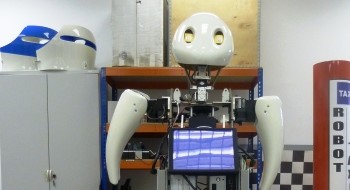
Barcelona Robot Laboratory
The Barcelona Robot Lab encompasses an outdoor pedestrian area of 10.000 sq m., and is provided with 21 fixed cameras, a set of heterogeneous robots, full coverage of wifi and mica devices, and partial gps coverage. The area has moderate vegetation and intense cast shadows, making computer vision algorithms more than challenging.
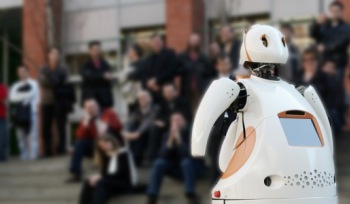

Researchers
-
Andrade Cetto, Juan
 cetto (at) iri.upc.edu
cetto (at) iri.upc.edu
-
Bo, Valerio
 vbo (at) iri.upc.edu
vbo (at) iri.upc.edu
-
del Pino Bastida, Iván
 idelpino (at) iri.upc.edu
idelpino (at) iri.upc.edu
-
Garrell Zulueta, Anaís
 agarrell (at) iri.upc.edu
agarrell (at) iri.upc.edu
-
Puig-Pey Claveria, Ana Maria
 apuigpey (at) iri.upc.edu
apuigpey (at) iri.upc.edu
-
Sanfeliu Cortés, Alberto
 sanfeliu (at) iri.upc.edu
sanfeliu (at) iri.upc.edu
-
Santamaria Navarro, Angel
 asantamaria (at) iri.upc.edu
asantamaria (at) iri.upc.edu
-
Solà Ortega, Joan
 jsola (at) iri.upc.edu
jsola (at) iri.upc.edu
-
Vallvé Navarro, Joan
 jvallve (at) iri.upc.edu
jvallve (at) iri.upc.edu
PhD Students
-
Albardaner Torras, Jaume
 jalbardaner (at) iri.upc.edu
jalbardaner (at) iri.upc.edu
-
Bejarano Sepulveda, Edison Jair
 ebejarano (at) iri.upc.edu
ebejarano (at) iri.upc.edu
-
Costa Santamaria, Adrià
 acostas (at) iri.upc.edu
acostas (at) iri.upc.edu
-
Dalmasso Blanch, Marc
 mdalmasso (at) iri.upc.edu
mdalmasso (at) iri.upc.edu
-
De Frutos Arranz, Raquel
 rdefrutos (at) iri.upc.edu
rdefrutos (at) iri.upc.edu
-
Gebelli Guinjoan, Ferran
 fgebelli (at) iri.upc.edu
fgebelli (at) iri.upc.edu
-
Hriscu Acsinte-Staut, Lavinia Beatrice
 lhriscu (at) iri.upc.edu
lhriscu (at) iri.upc.edu
-
Sanches Moura, Mateus
 msanches (at) iri.upc.edu
msanches (at) iri.upc.edu
-
Taher, Hafsa
 htaher (at) iri.upc.edu
htaher (at) iri.upc.edu
-
Wang, Zhixiong
 zhwang (at) iri.upc.edu
zhwang (at) iri.upc.edu
-
Zhang, Na
 nzhang (at) iri.upc.edu
nzhang (at) iri.upc.edu
Master Students
-
Carles Pamias, Sara
 scarles (at) iri.upc.edu
scarles (at) iri.upc.edu
-
Li, Yunju
 yli (at) iri.upc.edu
yli (at) iri.upc.edu
-
Tur Ruiz, Joan
 jtur (at) iri.upc.edu
jtur (at) iri.upc.edu
TFG Students
-
Arcos Conchillo, Diego
 darcos (at) iri.upc.edu
darcos (at) iri.upc.edu
-
Michalkova, Soña
 smichalkova (at) iri.upc.edu
smichalkova (at) iri.upc.edu
-
Minguella Torra, Maria
 mminguella (at) iri.upc.edu
mminguella (at) iri.upc.edu
-
Ni, Huilin
 hni (at) iri.upc.edu
hni (at) iri.upc.edu
-
Park Gonzalez, Nicolas Gil
 npark (at) iri.upc.edu
npark (at) iri.upc.edu
-
Sánchez Gala, Iván
 isanchez (at) iri.upc.edu
isanchez (at) iri.upc.edu
-
Zakreva Prykolota, Anna Maria
 azakreva (at) iri.upc.edu
azakreva (at) iri.upc.edu
Support Staff
-
Herrero Cotarelo, Fernando
 fherrero (at) iri.upc.edu
fherrero (at) iri.upc.edu
-
Martínez Fité, Oriol
 omartinez (at) iri.upc.edu
omartinez (at) iri.upc.edu
-
Moreno Borràs, Víctor
 vmoreno (at) iri.upc.edu
vmoreno (at) iri.upc.edu
-
Perez Ruiz, Carlos
 cperez (at) iri.upc.edu
cperez (at) iri.upc.edu

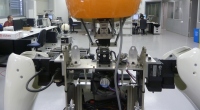























Follow us!